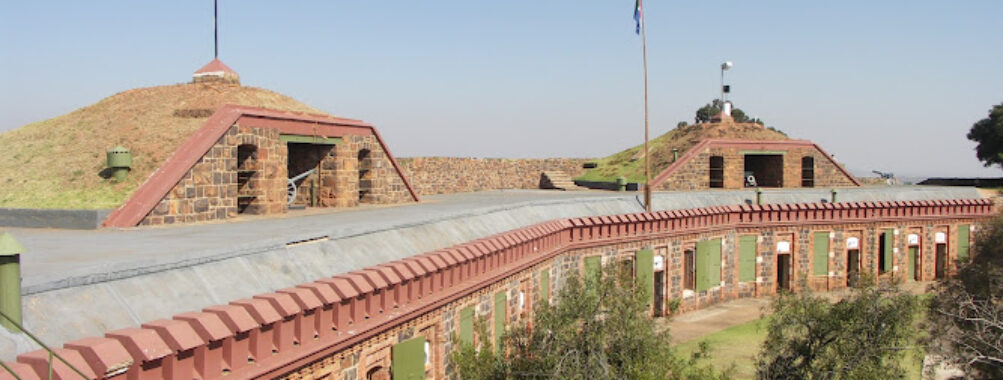
Fort Klapperkop
“`html
Table of Contents
Description
Fort Klapperkop stands quietly on a hill overlooking Pretoria, its stone walls whispering stories of South Africa’s turbulent past. Built in 1898, just before the outbreak of the Anglo-Boer War, this fort was one of four constructed to protect the capital. Walking through its corridors today, you can almost feel the tension that must have hung in the air back then — soldiers on edge, the sound of boots echoing against stone, and the weight of uncertainty before battle. It’s not just a museum; it’s a time capsule that takes you back more than a century.
The fort has been carefully restored, and the attention to historical accuracy is pretty impressive. The museum inside showcases an array of artifacts — from uniforms and rifles to maps and personal effects left behind by those who once called this place their post. There’s something deeply moving about seeing objects that were part of real lives lived in such uncertain times. It’s educational, sure, but also strangely emotional.
I remember my first visit — I went on a slightly windy afternoon, and the sound of the flag flapping above the fort was oddly haunting. The panoramic view of Pretoria from the top is breathtaking, especially when the light shifts in the late afternoon. It’s one of those places where history feels alive, not locked behind glass cases. And while some visitors might find the fort’s simplicity underwhelming, others (like me) find its quiet authenticity refreshing.
Fort Klapperkop isn’t flashy. It’s not a massive, high-tech museum with touchscreens and holograms. Instead, it’s a place that invites you to slow down, to imagine, and to listen. The atmosphere is calm, sometimes even eerie, but always fascinating. For history buffs, photographers, or anyone curious about South Africa’s past, it’s a must-see stop in Pretoria.
Key Features
- Authentic 19th-century military architecture designed by German engineers from Krupp.
- Permanent exhibitions featuring weapons, uniforms, and personal artifacts from the Anglo-Boer War.
- Panoramic views of Pretoria and the surrounding countryside — perfect for photography.
- Restored interiors that show what life was like for soldiers stationed here over a century ago.
- Wheelchair-accessible entrances and parking for visitors with mobility needs.
- Peaceful picnic spots and open grounds where you can take a quiet stroll after exploring the museum.
- Occasional wildlife sightings — yes, you might spot some antelope or birds wandering nearby.
- Good for kids who enjoy exploring forts, cannons, and learning about history in an interactive way.
Best Time to Visit
If you ask me, the best time to visit Fort Klapperkop is during the cooler months — from April to September. The air is crisp, the skies are clear, and the city views stretch endlessly. Mornings and late afternoons are especially magical; the golden light makes the old stone walls glow, and you’ll get some fantastic photos. Summer can be hot and a bit unpredictable with sudden thunderstorms, but even then, the moody skies can add a dramatic flair to your visit.
Weekdays tend to be quieter, which is great if you prefer a more reflective experience. On weekends, you’ll find more families and local visitors enjoying the open grounds. I actually love going on a Sunday morning — there’s something peaceful about sipping coffee on the hilltop while the city slowly wakes up below.
How to Get There
Getting to Fort Klapperkop is fairly straightforward. It’s located just a short drive from central Pretoria, and the route takes you through some scenic parts of the city. If you’re driving, follow the signs leading up to the fort — the road winds gently uphill, offering glimpses of the skyline as you ascend. There’s free parking available near the entrance, and it’s well-maintained.
For those without a car, you can easily grab a taxi or rideshare from anywhere in Pretoria. Some local tour companies also include the fort as part of their historical city tours, which can be a convenient way to see multiple landmarks in one go. Just remember, public transport options directly to the fort are limited, so planning ahead is key.
Tips for Visiting
Here’s some honest advice from someone who’s been there more than once — don’t rush your visit. Give yourself at least an hour or two to wander, read the displays, and just soak in the setting. The museum isn’t massive, but every corner has a story.
- Bring water and snacks: There’s no restaurant or café on-site, so pack something light if you plan to stay awhile.
- Wear comfortable shoes: The paths around the fort can be uneven, and you’ll definitely want to explore the grounds.
- Check the weather: Pretoria can get quite hot in summer, so a hat and sunscreen are must-haves.
- Photography tip: The view of the city at sunset is phenomenal — bring your camera or phone fully charged.
- Go early or late: Mornings are calm and cool, while evenings offer dramatic skies and fewer crowds.
- Respect the site: It’s not just a tourist attraction; it’s a memorial to those who lived and fought here.
And one more thing — take a moment on the ramparts to just stand still and imagine what it must’ve felt like over a hundred years ago. The landscape hasn’t changed that much, and for a brief second, you might feel connected to the people who once looked out from the same spot, wondering what the future held. It’s those quiet, reflective moments that make Fort Klapperkop more than just a museum — it’s a living piece of history that still speaks, softly but powerfully, to anyone willing to listen.
“`
Location
Places to Stay Near Fort Klapperkop
Find and Book a Tour
Explore More Travel Guides
No reviews found! Be the first to review!